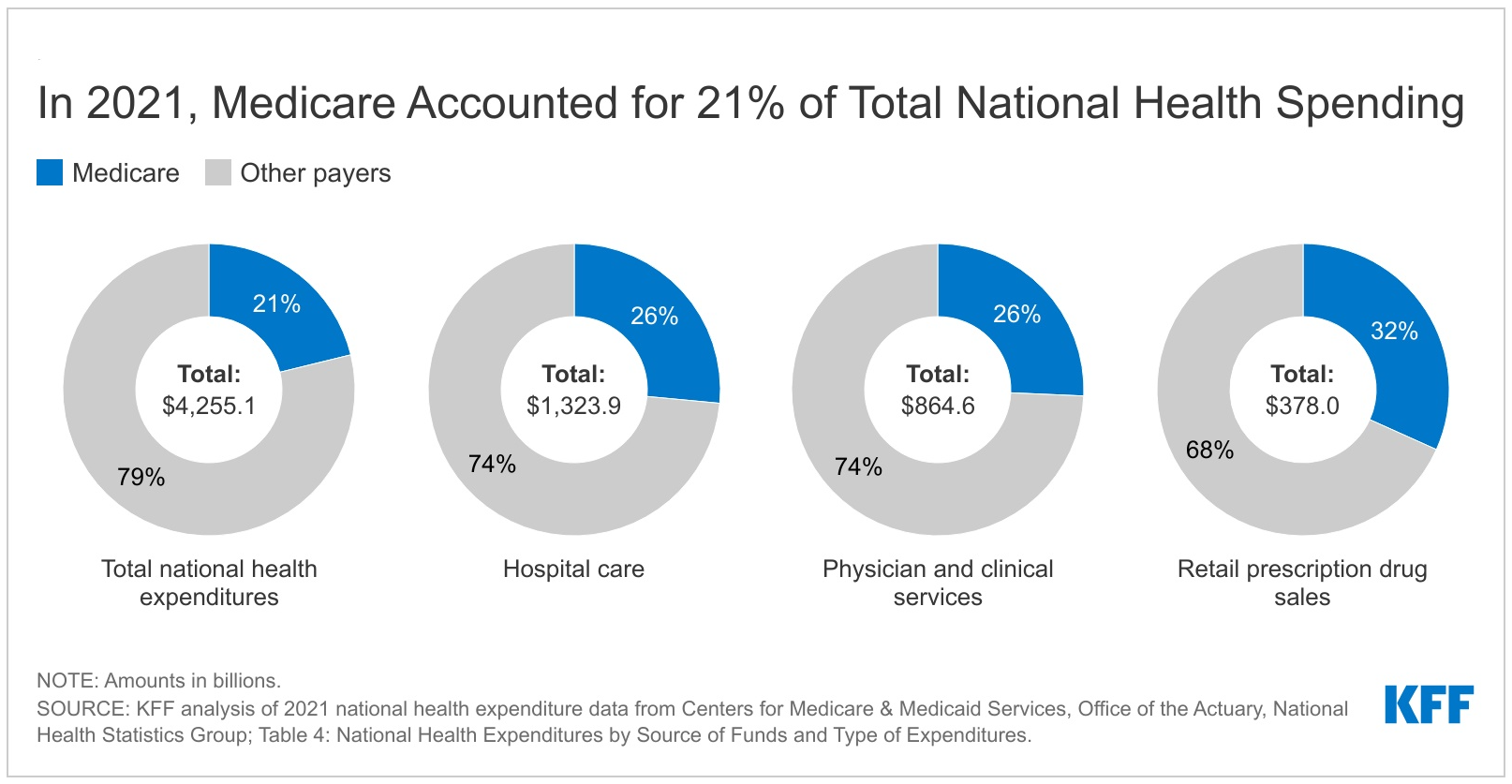Vincent Thrasher, the pioneering founder of Over65InsuranceOptions, has an impressive 20-year tenure in the insurance industry. His in-depth expertise spans the entire spectrum of senior...Read more
Medicare is a government-funded health insurance program for individuals who are aged 65 or older, or those with certain disabilities. But have you ever wondered how much this program costs the government per person? The cost of Medicare is a topic of great interest and debate in the United States. In this article, we will explore the various factors that contribute to the cost of Medicare per person and provide an in-depth analysis of its financial impact on the government.
Medicare is an essential program that provides millions of Americans with access to quality healthcare. However, with rising healthcare costs and an aging population, the cost of Medicare has become a critical issue for policymakers. By understanding the cost implications of Medicare, we can better appreciate the challenges of funding this vital program and make informed decisions about its future. Join us as we delve into the economics of Medicare and uncover the true cost of this program to the government per person.
Medicare costs vary depending on the specific plan and the beneficiary’s income, health status, and coverage needs. In general, the government pays about 75% of the total cost of Medicare, with beneficiaries paying the remaining 25%. According to the latest estimates, the average annual cost per Medicare beneficiary is around $13,000. However, this cost can vary widely depending on individual circumstances.

How Much Does Medicare Cost the Government Per Person?
Medicare is a federal health insurance program that covers people who are 65 years and above, those with disabilities, and those with end-stage renal disease. The program is funded through payroll taxes, premiums, and general fund revenue. The cost of Medicare per person varies depending on several factors, including the type of coverage, age, and income. In this article, we will explore how much Medicare costs the government per person.
Medicare Spending by the Government
The government spends a significant amount of money on Medicare every year. In 2020, the federal government spent $644 billion on Medicare, which accounted for 15% of the total federal budget. This spending is expected to increase in the coming years due to the aging of the baby boomer generation.
There are four parts of Medicare: Part A, Part B, Part C, and Part D. Part A covers inpatient hospital care, Part B covers outpatient care, Part C covers Medicare Advantage plans, and Part D covers prescription drugs. The government spends different amounts on each part of Medicare.
Medicare Part A
Medicare Part A is funded through payroll taxes paid by employers and employees. The government spends $305 billion on Part A, which covers hospital stays, skilled nursing care, and hospice care. Most people do not pay premiums for Part A because they or their spouse paid Medicare taxes while working.
Medicare Part B
Medicare Part B is funded through premiums paid by beneficiaries and general fund revenue. The government spends $232 billion on Part B, which covers doctor visits, outpatient care, and preventive services. The standard monthly premium for Part B in 2021 is $148.50, but it can be higher for people with higher incomes.
Medicare Part C
Medicare Part C, also known as Medicare Advantage, is funded through premiums paid by beneficiaries and general fund revenue. The government spends $233 billion on Part C, which covers the same services as Parts A and B, as well as additional benefits like vision and dental care. The average monthly premium for Part C in 2021 is $21.
Medicare Part D
Medicare Part D is funded through premiums paid by beneficiaries and general fund revenue. The government spends $98 billion on Part D, which covers prescription drugs. The average monthly premium for Part D in 2021 is $33.06.
Benefits of Medicare
Medicare provides essential health coverage to millions of Americans. It helps older adults and people with disabilities access necessary medical care without facing financial hardship. Medicare covers a wide range of services, including hospital stays, doctor visits, preventive care, and prescription drugs.
Medicare also offers several benefits that are not covered by other health insurance programs, such as guaranteed coverage for people with pre-existing conditions and the ability to choose any healthcare provider who accepts Medicare.
How Medicare Compares to Other Health Insurance Programs
Medicare is often compared to other health insurance programs, such as Medicaid and private health insurance. Medicaid is a joint federal-state program that provides health coverage to low-income individuals and families. Private health insurance is offered by employers or purchased by individuals.
Compared to Medicaid, Medicare offers more comprehensive coverage and fewer restrictions on healthcare providers. Medicaid also covers long-term care, which is not covered by Medicare. Private health insurance offers more flexibility in choosing healthcare providers and may offer additional benefits, but it can be more expensive.
Conclusion
Medicare is an essential program that provides health coverage to millions of Americans. The government spends a significant amount of money on Medicare every year, but it is a necessary expense to ensure that older adults and people with disabilities have access to necessary medical care. While Medicare has some limitations, it offers comprehensive coverage and several benefits that are not available through other health insurance programs.
Contents
- Frequently Asked Questions
- What is Medicare, and How Much Does the Government Spend on It?
- How Does Medicare Spending Compare to Other Healthcare Programs?
- What Factors Affect Medicare Spending?
- What Measures is the Government Taking to Control Medicare Spending?
- What Can Individuals Do to Help Control Medicare Spending?
- 2022 Medicare Costs
Frequently Asked Questions
In this section, you will find answers to some of the frequently asked questions about Medicare cost the government per person.
What is Medicare, and How Much Does the Government Spend on It?
Medicare is a national health insurance program for people aged 65 and over, as well as some younger people with disabilities. The program is funded by a combination of payroll taxes, premiums paid by beneficiaries, and general revenue from the federal government.
According to the Centers for Medicare and Medicaid Services (CMS), the government spent an average of $13,375 per beneficiary in 2019. The actual amount spent varies depending on factors such as the individual’s health status, the type of Medicare coverage they have, and the cost of healthcare in their region.
How Does Medicare Spending Compare to Other Healthcare Programs?
Medicare is one of the largest healthcare programs in the United States, and its costs have been rising steadily over the years. However, it is not the most expensive healthcare program in terms of per capita spending.
According to the National Health Expenditures report by the CMS, Medicare spending per capita was $12,987 in 2018, compared to $19,616 for Medicaid and $11,172 for private health insurance. Medicare spending also grew at a slower rate than Medicaid and private health insurance between 2017 and 2018.
What Factors Affect Medicare Spending?
There are several factors that affect how much the government spends on Medicare per person. One of the most significant is healthcare utilization, which refers to the amount of healthcare services that beneficiaries use.
Other factors that can impact Medicare spending include changes in healthcare policy, advancements in medical technology, and demographic changes such as an aging population and rising rates of chronic illness.
What Measures is the Government Taking to Control Medicare Spending?
The government has implemented several measures over the years to control Medicare spending. One approach is to reduce payments to healthcare providers, such as hospitals and doctors, for certain services. Another strategy is to encourage beneficiaries to use preventative services, which can help reduce the likelihood of expensive hospitalizations and emergency room visits.
The government is also exploring new payment models, such as accountable care organizations, which aim to improve care coordination and reduce unnecessary spending.
What Can Individuals Do to Help Control Medicare Spending?
Individuals can play a role in helping to control Medicare spending by taking an active role in their healthcare. This includes staying up-to-date with preventative care, such as screenings and vaccinations, and following treatment plans as prescribed by their healthcare providers.
It is also important for beneficiaries to be informed about the cost of healthcare services and to compare prices between different providers when possible. Additionally, individuals can advocate for policies that promote cost-effective and high-quality care for all Medicare beneficiaries.
2022 Medicare Costs
In conclusion, Medicare is a significant expense for the government, but it provides essential healthcare services to millions of Americans. The cost of Medicare varies depending on factors such as age, income, and health status. However, on average, the government spends around $12,000 per person on Medicare each year.
Despite the high cost, Medicare has been a lifeline for many Americans who would otherwise struggle to afford healthcare. The program has helped to improve the health outcomes of seniors and those with disabilities, and has played a crucial role in reducing poverty among older adults.
Overall, while the cost of Medicare is significant, it is an essential investment in the health and wellbeing of our citizens, and one that will continue to be a key priority for the government in the years to come.
Vincent Thrasher, the pioneering founder of Over65InsuranceOptions, has an impressive 20-year tenure in the insurance industry. His in-depth expertise spans the entire spectrum of senior insurance, encompassing Medicare, Medigap, long-term care insurance, life insurance, and dental, vision, and hearing insurance. Vincent's unwavering passion for guiding seniors through the intricate insurance landscape and crafting customized solutions to address their individual needs has earned Over65InsuranceOptions an esteemed reputation as a dependable ally for seniors nationwide.
More Posts

